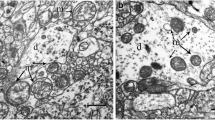Summary
The collagen content (measured as myocardial concentration of hydroxyproline) and dry weight (expressed as ventricle weight to body weight ratio) were determined in the left ventricle of male Sprague-Dawley rats (200–220 g b.wt.) exposed to a simulated altitude of 7,000 m for 18 h a day for 10 days in a hypobaric chamber. Hypoxia resulted in a significant increase (P<0.001) in the mass of the left ventricle with a concomitant significantly increased collagen concentration (P<0.001). The data indicate that hypoxia effects the synthesis of a significant amount of connective tissue in the left ventricle, which is the ventricle not exposed to pressure load.
These results may be related to clinical, hemodynamic, and pathologic observations showing the left ventricular dysfunction in patients with chronic respiratory insufficiency. Since the amount of collagen in the left ventricle might interfere with ventricular contractile function, it is suggested that the hypoxia in these patients could affect the left ventricular myocardium via a direct action on the connective metabolism.
Similar content being viewed by others
References
Asmussen E, Nielsen M (1955) The cardiac output in rest and work at low and high oxygen pressures. Acta Physiol Scand 35:73–83
Bergman J, Loxley R (1963) Two improved and simplified methods for the spectrophotometric determination of hydroxyproline. Anal Chem 35:1961–1965
Buccino RA, Harris E, Spann JF Jr, Sonnenblick EM (1969) Response of myocardial connective tissue to development of experimental hypertrophy. Am J Physiol 216:425–428
Chidsey CA, Frye RL, Kamler RL, Braunwald E (1961) Influence of syngoserpine on the cardiovascular response to acute hypoxemia and exercise. Circ Res 9:989–995
Chvapil M, Hurych J (1968) Control of collagen biosynthesis. In: Hall DA (ed) Review of connective tissue research. Academic Press, New York, pp 67–196
Cutilletta AF, Dowell RT, Rudnik M, Arcilla RA, Zak R (1975) Regression of myocardial hypertrophy. I. Experimental model, changes in heart weight, nucleic acids and collagen. J Mol Cell Cardiol 7:767–781
Downing SE, Remensnyder JP, Mitchell JH (1962) Cardiovascular responses to hypoxic stimulation of the carotid bodies. Circ Res 10:676–685
Fulton RM, Hutchinson EC, Morgan JA (1952) Ventricular weight in cardiac hypertrophy. Br Heart J 14:413–420
Genovese A, Chiariello M, Cacciapuoti AA, De Alfieri W, Latte S, Condorelli M (1980) Inhibition of hypoxia-induced cardiac hypertrophy by verapamil in rats. Basic Res Cardiol 75:757–763
Genovese A, De Alfieri W, Latte S, Chiariello M, Condorelli M (1982) Regression of myocardial hypertrophy in the rat following removal of acute or chronic hypobaric hypoxia. Eur Heart J [Suppl A] 3:161–164
Hultgren HN, Spickard WB, Hellriegel K, Houston CS (1961) High altitude pulmonary edema. Medicine 40:289–313
Kahler RL, Goldblatt A, Braunwald E (1962) The effects of acute hypoxia on the systemic venous and arterial systems and on myocardial contractile force. J Clin Invest 41:1553–1563
Lund DD, Twietmeyer AT, Schmid PG, Tomanek RJ (1979) Independent changes in cardiac muscle fibres and connective tissue in rats with spontaneous hypertension, aortic constriction and hypoxia. Cardiovasc Res 13:39–44
Meerson FZ (1974) Development of modern components of the mechanism of cardiac hypertrophy. Circ Res [Suppl II] 35:58–63
Michelson N (1960) Bilateral ventricular hypertrophy due to chronic pulmonary disease. Dis Chest 38:435–446
Murphy ML, Adamson J, Hutcheson F (1974) Left ventricular hypertrophy in patients with chronic bronchitis and emphysema. Ann Int Med 81:307–313
Rabinovitch M, Gamble W, Nadas AS, Mietinen OS, Reid L (1979) Rat pulmonary circulation after chronic hypoxia: hemodynamic and structural features. Am J Physiol 236:H818–827
Rao BS, Cohn KE, Eldridge FL, Mancock EW (1968) Left ventricular failure secondary to chronic pulmonary disease. Am J Med 45:229–241
Snedecor GW, Cochran WG (1967) Statistical methods. Iowa City Press, Iowa
Vogel JHK (1970) Hypoxia, high altitude and the heart. In: Vogel JHK (ed) Advances in cardiology, vol 5. Karger, Basel.
Author information
Authors and Affiliations
Rights and permissions
About this article
Cite this article
Genovese, A., Latte, S., Bozzaotre, M. et al. Response of the left ventricular connective tissue to hypoxia. Res. Exp. Med. 183, 111–115 (1983). https://doi.org/10.1007/BF01851776
Received:
Accepted:
Issue Date:
DOI: https://doi.org/10.1007/BF01851776



